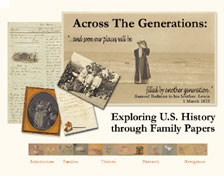talking history | syllabi | students | teachers | puzzle | about us
Across the Generations: Exploring U.S. History through Family Papers
http://www.smith.edu/libraries/libs/ssc/atg/index.html
Created and maintained by the Sophia Smith Collection, Smith College, Northampton, Mass.
Reviewed March 22—April 9, 2003.

The home page offers a preview of the types
of family papers available on this site.
Across the Generations is a revealing but limited introduction to the possibilities of using family papers to study U.S. history. An online exhibit of letters, account books, photographs, and other documents generated by four prominent northeastern families from the late eighteenth through the early twentieth centuries, this site highlights how a sustained examination of one family’s papers can illuminate historical change over time. The producer and content provider for this exhibit is Smith College’s Sophia Smith Collection, one of the nation’s leading repositories for sources on women’s history.
An attractive front page featuring a collage of letters and photographs greets users, along with a simple horizontal menu bar for navigation. Reading family papers can be a haphazard experience, as letters, in particular, often veer quickly in content from the weather to politics to gossip. This site provides a simple guide by offering two ways to navigate: by family (the Hales, the Garrisons, the Dunhams, and the Bodmans) or by one of four themes (Family Life, Social Awareness and Reform, Arts and Leisure, and Work). Each family or theme has its own page, with short, interpretive text interspersed with excerpts from the documents. Each excerpt is accompanied by links to the entire document—both a scanned image and a transcription. Such options are helpful, although users must open a cumbersome two extra windows in order to view a full transcript and image side by side.
The documents provided are instructive and well chosen. Excerpts from Bodman family account books, for example, juxtapose an eighteenth-century ledger documenting hay cultivation with a twentieth-century account book listing stock sales during the Great Depression—a revealing look at a family’s (and a nation’s) changing economic fortunes over time. The Garrison family’s page features a photograph of the abolitionist William Lloyd Garrison’s granddaughter, Eleanor, wearing a suffrage sash—a fascinating glimpse at the interconnections of nineteenth-century reform movements. The documents, indeed, are so revealing that at times the accompanying text is distracting. These families are referred to as “traditional” in the general introduction and as exhibiting “typical gender roles” in the Family Life text. Such generalizations are counterproductive, particularly on a site that highlights change over time and gives users the opportunity to examine these categories for themselves.
The exhibit’s producers do not claim to be comprehensive, explaining that they intend only to offer “glimpses of a handful of moments in American history through the eyes of individuals who experienced them.” A total of sixty-three documents are included, not quite enough to draw comparisons between the families or to assess change over time effectively, and not quite enough for a substantive classroom exercise or research project. The documents mainly provide a teaser, enticing users to visit the Sophia Smith Collection to see more. And if that is the exhibit’s ultimate goal, then the producers have succeeded. But if this site is intended to make a strong case for using family papers, then it should take full advantage of the archiving capabilities of digital technology and provide users with more documents to explore.
Amy Murrell
State University of New York
Albany, New York
